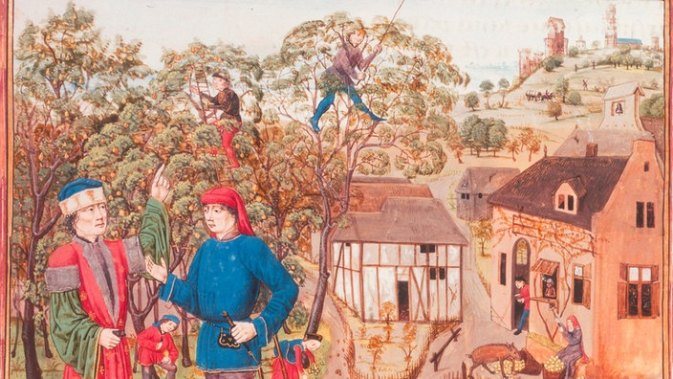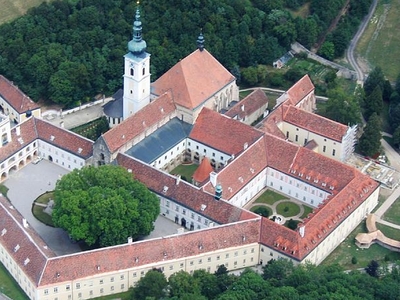Image featured above: The Heidentor, in English known as Heathens’ Gate or Pagans’ Gate, is the partially reconstructed ruin of a triumphal arch of the Roman Empire, located in what was the fort-city of Carnuntum, in present-day Austria. Only one of its four arches remains.
Estimated reading time: 8 minutes
PRE-ROMAN AND ROMAN ERAS
While the Romans were responsible for spreading the grapevine to many parts of Europe, Austria is considered one of the European regions where the Celts, and possibly the Illyrians as well, introduced viticulture during the Hallstatt Culture corresponding to the First Iron Age. This is evidenced by the discovery of Vitis vinifera seeds in Celtic dwellings in the village of Zagersdorf in Austria’s federal state of Burgenland. Grape pips dating from the Bronze Age have also been found in Lower Austria.

From 200 BC the various Celtic tribes would form the kingdom of Noricum and begin a profitable trade with the Romans, exchanging their high-quality iron weapons for military protection. Noricum was incorporated into the Roman Empire in 16 BC, and over the next one hundred years the expansion of vineyards was so great that in 92 AD Emperor Domitian ordered the destruction of existing vineyards in the region and prohibited the establishment of new ones. Two centuries later, Emperor Marcus Aurelius Probus rescinded the order and encouraged the establishment of new vineyards in Pannonia, the vast plain which includes the eastern part of modern Austria.
CHARLEMAGNE’S INFLUENCE AND THE MIDDLE AGES

In the fifth century, Saint Severinus of Noricum established vineyards near the town of Mauntern an der Donau, the first planted in the Wachau region. The Romans left Noricum towards the end of the same century, leaving many vineyards abandoned. During the next three hundred years, the territory would be invaded by the Goths, the Slavs, and the Baiuvarii. Charlemagne took control of the territory in 788, and a few years later established rules governing viticulture and vinification, a part of his great legislative act, Capitulare de Villis.
A new threat appeared in 862, the Magyars, following a pattern of displacement by superior forces from eastern territories. Around 896, the Magyars were present in great number on the Hungarian Plain, from which they assaulted the French dominions. This resulted in a drastic setback for viticulture. In 955, King Otto I of Germany successfully repelled the Magyars at the Battle of Lechfeld, initiating a slow reconquest of the eastern lands.
With the establishment of the Margraviate of Austria in 976 and the arrival of the House of Bamberg in Vienna, the region grew in influence and culture. In the twelfth century, Vienna became the cultural center of the German-speaking world. And for the first time, Viennese citizens were allowed to own vineyards. Until today the city of Vienna boasts a large number of vineyards.

The Cistercians also arrived in the twelfth century and in 1133 established the Heiligenkreuz Abbey (pictured left) near Vienna. With their research and techniques brought from Burgundy, the monks would drastically improve the quality of viticulture and winemaking. Today, Heiligenkreuz is the oldest continuously occupied Cistercian monastery in the world.
In 1327, the Seitzerkeller was established in Vienna’s Dorotheergasse. It is a type of pub (Trinkstube in German) where the proprietor serves wine produced from his own vineyards. The concept quickly became popular, and soon the city had more than sixty of these Trinkstuben.
16th TO THE 20th CENTURY
Until the 16th century, it is estimated that Austria had more than 150,000 hectares (370,658 acres) of vineyards. Three times more than today. At the same time, the sweet wines from the village of Rust became popular among the royals. And while the Thirty Years’ War left Germany destitute, it had little effect on daily life in eastern Austria. The arrival of the Turkish Army in the 17th century did indeed have a negative effect on Viennese viticulture. With vineyards destroyed and a fall in prices in general, vineyard area planted would continue to diminish.

After the time of Napoleon, the so-called Biedermeier period, a well-to-do middle class began to emerge, a class with a taste for good food and wine. The Hapsburg Empire became known for its viticultural expertise, and in 1860 the first institute and research center dedicated to viticulture and winemaking was established near Vienna, Klosterneuburg Wine Institute. But the good times would be short-lived. Phylloxera, the vine louse, was soon discovered in Austrian vineyards, leading to the death of 25% of the territory’s vines.

While there was a certain amount of recovery by the start of World War I, the end of the war would see the dismantling of the Empire, which would result in an even greater loss of vineyard area. But research at Klosterneuburg continued, and in 1922 the institute’s director, Friedrich Zweigelt (pictured left), crossed two Austrian grape varieties, Blaufränkisch and Sankt Laurent, to create the Zweigelt variety. Zweigelt today is Austria’s most widely planted red variety. Unfortunately, the fact that Zweigelt was a member of the Nazi party tarnished his reputation, although his membership would allow him to remain director of the institute until 1945. As in much of Europe, World War II was also devastating to Austria’s wine industry, although in this case the plunderers were the Soviets and not the Germans.
The reconstruction of Austria’s wine industry in the 1950s centered on efficiency and mechanization. The Austrian winemaker, Lenz Moser, was a proponent of the high vine training system known as Hochkultur (pictured right). This training system, with the vines trained on high wires, reduced labor costs, increased vine productivity, and facilitated mechanization. Enter the Grüner Veltliner grape variety. Although the variety had been cultivated for some time in eastern Austria, its share of vineyard area increased with the use of the Hochkultur vine training system. The variety could produce vast quantities of wine although of mediocre quality. The Hochkultur system has been largely replace by other, better vine training systems and is hardly seen anywhere in modern Austrian vineyards.

THE HEURIGE TRADITION LEADS TO SCANDAL

During his ten-year reign as Archduke of Austria (1780 – 1790), Joseph II (pictured left) would issue some 6,000 edicts and more than 11,000 new laws designed to reorder and improve the empire. Although not all were popular, one of the positive effects on wine culture was the establishment of Heurigen on 17 August 1784. The Heurige (as they are known in Vienna; more commonly known as Buschenshanke in other parts of the country) is a type of inn which serves only wine produced by the inn’s owner. Each Heuriger is open only during certain times of the year. Traditionally, only cold foods are served, and in general there are a few small rooms and a garden where family and friends can gather. A pine branch is hung over the inn’s entrance to show that it is open. They are very popular throughout the country.
Due to the popularity of the Heurigen, domestic consumption of Austrian wine was very high during the 20th century, and nearly all of the small amount of wine exported was bought by the Germans. After World War II, particularly during the 1970s and 1980s, tourism boomed in the country, especially the German tourists. Demand grew, and at some point, the consumption and export of Austrian wine magically grew to more than could possibly be produced. During this same time period, Germany was implementing new laws striving to improve the quality of German wine, and the noble sweet wines of Germany were relatively expensive. Austrian wines, on the other hand, were relatively inexpensive and popular with the frugal German consumer. A few unscrupulous merchants discovered that adding a tiny amount of diethylene glycol to Austrian wines would add body and viscosity to the wines, reminiscent of sweet wines made from grapes affected by Botrytis cinerea, the fungus responsible for the lusciously sweet wines like the Sauternes of France, Germany’s Beerenauslesen and Trockenbeerenauslese, and Hungary’s Tokaji. Although diethylene glycol, a component of automobile antifreeze, is indeed poisonous, it is not known if anyone actually died from consuming the tainted wines. But the bubble burst in 1985 when one of the offending wine producers was caught trying to write off the chemical in his tax returns. The tax inspector had some knowledge of winemaking and realized that something was awry. Notice of the scandal spread quickly around the globe. Some countries immediately banned the importation of Austrian wines. Several producers were sent to prison. One of them committed suicide. Some 27 million liters (7,132,668 gallons) of tainted wine had to be destroyed. Austria’s wine industry collapsed overnight, and it would be fifteen years before it fully recovered.
A SLOW BUT SUCCESSFUL RECOVERY
But the Austrian government reacted quickly and decisively. Within a year new wine laws were enacted, the strictest in all of Europe. In 1986, the Austrian Wine Marketing Board was established with the goal of promoting the image and sale of Austrian wines. The new generation of winemakers created a new model focusing on lower yields and higher quality. Slowly, the profile of Austrian wine changed, and with it, the perceptions of consumers and experts worldwide. The phoenix had risen from the ashes. Today, Austrian wines are sought after around the world. Austrian sweet wines, although high quality, are a niche product. The great majority are high-quality dry wines. And in 2020, in spite of the Covid-19 pandemic, Austrian wine exports increased 6.3% to 67.4 million liters (17,805,252 gallons). In the 1980s, after the scandal, wine exports were not even 5 million liters (1,320,864 gallons) annually. Also, in 2020, export revenue increased 2.4% to a record €187.3 million ($221,298,736.00). Yes, the future looks bright for Austrian wine!
Ready to plan your trip to Austria? I’m ready to help! Inquiries about wine tours at gregory @ gregorysmith.wine.
Home | About | Contact | Consulting | Events | Education | Enotours | Recipes | Blog
Pingback: Austria wine industry » This Day in Wine History
Pingback: The Grape Varieties of Austria, Part 2 – Gregory Smith
Pingback: Austria’s Thermenregion Becomes the Country’s Eighteenth DAC – Gregory Smith